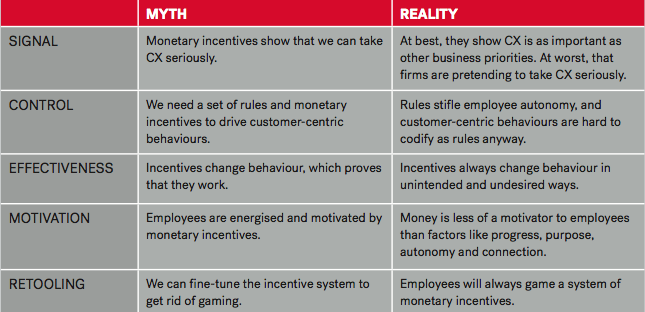Forrester mythbusters explain why incentivising CX never works
Share
Incentivising CX initiatives is a shortcut to damaged relationships with customers and employees, say Maxie Schmidt and Sam Stern. Here’s why.
This article originally appeared in The Simplicity Issue, our August/September 2018 issue of Marketing magazine.
 Firms that want to compete on customer experience (CX) often fall prey to the dazzling allure of ‘shortcuts’. But relying on these simplistic approaches for improving CX makes customer experiences worse.
Firms that want to compete on customer experience (CX) often fall prey to the dazzling allure of ‘shortcuts’. But relying on these simplistic approaches for improving CX makes customer experiences worse.
A good example is the question of whether to tie employee performance on CX metrics (e.g. satisfaction, Net Promoter Score) to monetary incentives (e.g. variable pay). Forrester gets this question a lot, and our answer is that it’s a risky shortcut that often undermines CX performance instead. When CX metrics drive employees’ variable pay, both CX and employee morale will suffer.
That’s because employees will ask, beg or guilt customers into giving them high ratings in surveys, which is a rude awakening for any customer who will now wonder whether an employee genuinely cared about them or was after a high survey score.

What’s more, firms that hold employees accountable for goals that they cannot achieve, demotivate them – for example, where processes, policies and tools in place contribute to low CX scores.
Linking accountability for CX metrics to variable pay also obstructs a firm’s CX efforts. First, it takes valuable time away from initiatives that make organisations more customer-centric. Forrester estimates that a CX team of a large company spends more than 1000 work hours a year on policing, optimising and governing the system.
For example, they argue with employees who want to exclude specific survey responses from the calculation, or they spend time confirming that employees didn’t pressure customers into giving higher scores.

Second, it handcuffs CX teams. For example, CX teams run into limits for changing existing customer surveys.
After all, any change could invalidate the baseline used to calculate the incentive payout – and we have even seen CX teams that held off on making significant CX improvements because the resulting score increase may have exceeded the incentive payout budget.
If you are wondering why so many firms still reach for this shortcut, Forrester identified myths that explain it.

Organisations that want to be successful with their CX efforts should avoid the incentive shortcut. Instead, they must put in the hard work required to make it simple for employees to deliver better CX. Here are four ways to get started:
Define metrics that measure whether delivered experiences meet or exceed customers’ expectations
Map your customers’ journeys and use feedback and qualitative research to identify customers’ expectations along the journey. Use these insights to define the right CX metrics that measure whether journeys deliver on CX expectations.
Identify what effective employee behaviours look like
Comb through feedback comments from customers for details about what they liked and disliked about their experiences. Supplement that with qualitative follow-up interviews with customers if you can. Then work with employees in front and back office to identify the specific behaviours that help improve CX quality perceptions.
Give employees ample and prompt feedback on their behaviours
Measure experience quality on an ongoing basis. Build that insight into targeted micro-learning modules that help employees practise their customer-centric behaviours.
Regularly acknowledge employees for their CX performance
Use CX metrics and customer and peer feedback to identify good and great employee performance. Set up events or special treats for employees who go above and beyond. The more management is involved with personal notes, shout-outs etc. the better.
You know that you have made delivering great CX simple for employees when employees stop chasing scores and instead use CX metrics and associated customer comments to check their progress on the behaviours they know are critical to delivering better CX.
Maxie Schmidt and Sam Stern are principal analysts at Forrester.
* * * * *
To purchase a copy of the latest issue, or a subscription to Marketing magazine, visit the online shop »
* * * * *
Image credit: Nathan Dumlao















